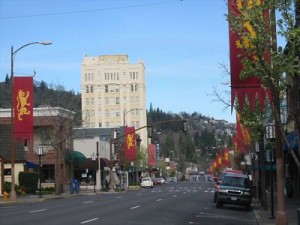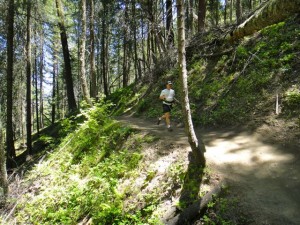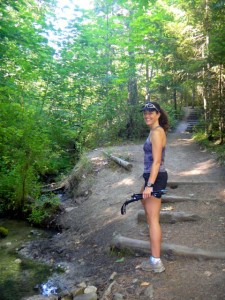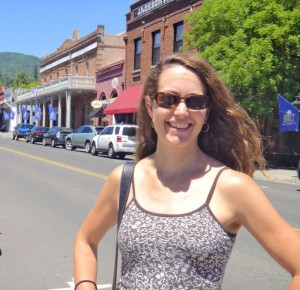After spending a week in Ashland, Oregon, I can see why it made Outside Magazine’s “Best Town Ever” shortlist.
The Shakespeare Festival is the hook that lures many visitors up there, but the recreational opportunities—especially the trails—prompted us to choose Southern Oregon as a quick and easy getaway destination. From the Bay Area, it’s just about five hours up the I-5.

Downtown with the historic Ashland Springs Hotel, where we stayed, the tallest building.
Morgan and I arrived without the kids (who were at sleep-away camp) and promptly walked all around downtown to scope it out. Shakespeare banners fluttered overhead from light posts, and the babbling of Ashland Creek, which flows through lovely Lithia Park and past the downtown’s core, provided a peaceful ambient sound. But it took us only half an hour to cruise around the shopping and dining district. In our still-decompressing-from-work mode, we both thought, “Gee, this place is pretty small—are we going to run out things to do and see?”
By the next day, however, I felt unhurried and grateful for the days to hang out and explore further. Everyone in Ashland seems to share a laid-back demeanor. The town (pop. approx. 20,000) attracts white-haired retirees who go to see Shakespeare plays, athletic-looking adults who mountain bike, raft and run, and raggedy rainbow dropouts who seem to smoke a lot of pot.
Smack in the middle of Main Street sits my favorite store, the Rogue Valley Runners, which champion trail/ultra runner Hal Koerner opened five years ago. “Ashland is a bit of a utopian society for a lot of people,” he says. “There are a lot who seem to be having a really good time, so you can’t help but feed off that.”
Where to run:
Stop by the Rogue Valley Runners store to buy a map of the Ashland Watershed trail system, which branches out from Lithia Park and leads to Mt. Ashland’s summit. If you’re at the store on a Wednesday at 5:30 p.m., you can join Hal, co-worker Erik Skaggs (the Quad Dipsea record holder) and others on a their weekly group trail run. I hooked up with the group and had a blast running through the woods with those guys.
Lots of trails branch out from the creekside path in Lithia Park (elev. 1900 feet) to the Pacific Crest Trail and Mt. Ashland (elev. 7530), forming what’s known as the “Creek to Crest Trail System.” I recommend running through the park to the trailhead at the intersection of Granite & Glenview, picking up the BTI and Alice In Wonderland trails, and heading up as far as you feel. The single-track trail climbs steadily through forests of pine and manzanita on switchbacks that criss-cross Lithia Loop Road. The dirt road provides an easier but less scenic option to run. Carry enough water, as none is available at the trailheads. Morgan and I ran an out-and-back, about 20 miles, on these trails to a point called Bull Gap.
For an alternate entrance to the trail system, go to the Oredson-Todd Woods on the east side of town (take Siskiyou Blvd east to Tolman Creek Road). A trailhead there picks up the White Rabbit Trail—a nice option for an out-and-back or to loop back to town.
And for those who want a bike path experience, Hal says, “a lot of people enjoy going on the Bear Creek Greenway, which is pretty easy to get to—a mile off of Main Street—and that affords some of the most flat running in Ashland, which is hard to get otherwise.” Access the path at the Ashland Dog Park at the end of Helman Street.
Where to eat:
Thanks to the Shakespeare Fest and the alternative lifestyle vibe, the downtown supports a wide range of restaurants. We had two good meals outside by the creek at the string of restaurants on North Main, across from the triangular Plaza: first at Greenleaf for a yummy tofu-topped rice bowls and salmon, then at Hana Sushi before seeing Love’s Labors Lost at the Shakespeare Fest. We also had a gourmet taco and tamale feast around the corner at Agave. We splurged on two stellar dinners: first at Amuse and then, about 10 minutes away toward the little town of Talent, at New Sammy’s Cowboy Bistro.
Where to stay:
We found the Ashland Springs Hotel, built in 1925, lovely and comfortable, if a bit stuffy. Good thing I don’t mind climbing stairs since that single small elevator is so slow. But, the service is great and the location on Main Street can’t be beat.
Where to day trip:
We had an enchanting backroads drive through vineyards and farmlands to the Gold Rush town of Jacksonville, where rehabbed 19th-century shops and taverns line Main Street. I was kicking myself, though, because I didn’t know about the town’s summer concert series, the Britt Fest, which has a fabulous lineup of folk-rock stars. If I had known, I would’ve planned to go. So, if you’re headed to Southern Oregon, check out the brittfest.org calendar!
Races to run:
The 34th annual Mt. Ashland Hill Climb on Aug. 6, 2011, is a half marathon starting downtown in Lithia Park that goes up 5600′ to the summit of Mt. Ashland. The event is limited to 300 and fills fast, so register early for the 2012 event.
Thanks to Koerner and the Rogue Valley Runners, Ashland has two relatively new endurance races on its calendar: the Pine to Palm 100M on Sept. 17, 2011, traversing the Siskiyou Mountains, which started last year, and the Lithia Loop Trail Marathon on Nov. 5, 2011, started in 2008. Check the Rogue Valley Runners site for additional races.
We experienced only a fraction of what the region has to offer. Next time we go—and I hope there’s a next time—we’ll take the kids to raft the Rogue River, hit some Southern Oregon wineries for tasting, explore more of the Siskiyou Mountains and see more than just one play.





Thanks for this article…there’s a lot of good info in there. I’m excited to be staying down there from July 8-11th and am running SOB 50k…have a great summer!
Hey Yassine, thanks for the feedback and for the reminder to add the SOB 50K (“Siskiyou Out Back”) under Races to Run, http://www.siskiyououtback.com.
Hope to meet you sometime; I enjoy following your impressive racing online. Have a great summer!
Sarah, just an FYI. The trees along Alice and BTI are predominantly douglas fir and Pacific Madrone (manzanita is a shrub found on south facing slopes like those above Oredson Todd). Although this area is considered a “dry” forest and used to be predominantly comprised of ponderosa pine, due to forest management procedures, includng wildfire suppression, the forests of the Ashland watershed have been transformed from those which were once open and comprised of pine to a closed-canopy, douglas fir forests.